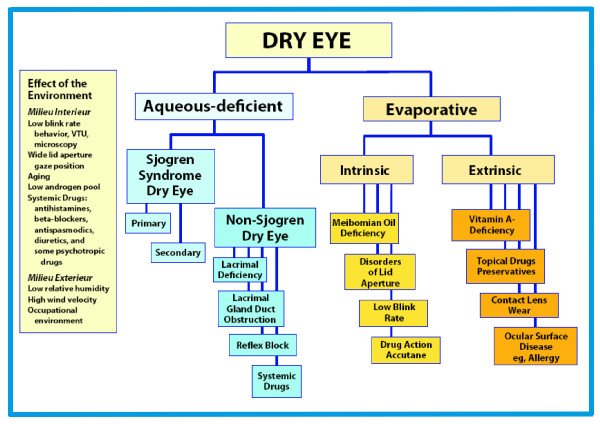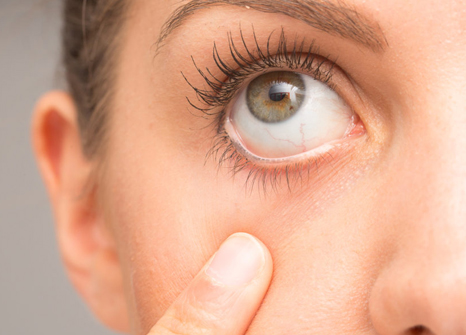Dry Eye Treatment at Smart Vision Eye Centre, Andheri
Are you struggling with dry, red, fatigued, or burning eyes? Discover comprehensive dry eye treatment solutions at Smartvision Eye Centre in Andheri, led by the experienced Dr. Seema Behl. Find relief and improve the health of your eyes with our advanced treatment options.
Understanding Dry Eye Syndrome
Dry eye syndrome results from inadequate lubrication and moisture on the eye's surface, leading to a range of symptoms from mild irritation to significant inflammation. It is a common condition that prompts many visits to eye care professionals.
Types and Causes of Dry Eye Syndrome
Dry eye syndrome can be triggered by various factors that disrupt the healthy tear film, which consists of fatty oils, aqueous fluid, and mucus. Understanding the underlying causes of dry eyes is crucial in managing this condition effectively.
Below flow chart will help in understanding different types of dry eye syndrome and it’s causes:

Common Causes of Dry Eyes:
1. Tear Film Dysfunction: Problems with any of the three layers of the tear film can lead to dry eyes. This dysfunction can result from hormone changes, autoimmune diseases, inflamed eyelid glands, or allergic eye disease.
2. Decreased Tear Production: In some cases, dry eyes occur due to insufficient tear production or increased tear evaporation. Factors like aging, hormonal changes, and certain medications can contribute to decreased tear production.
3. Increased Tear Evaporation: The oil film produced by meibomian glands on the eyelids may become clogged, leading to increased tear evaporation. Conditions like posterior blepharitis or reduced blinking frequency can exacerbate this issue.
4. Underlying Health Conditions: Certain illnesses such as rheumatoid arthritis, lupus, Graves' disease, diabetes, scleroderma, and Sjogren's syndrome can also contribute to dry eye syndrome.
5. Environmental Factors: Exposure to smoke, wind, dry air, and prolonged screen time can worsen dry eye symptoms by increasing tear evaporation and eye irritation.
6. Age and Gender: Individuals over 50 years old are more prone to dry eyes due to age-related changes in tear production. Women are also at a higher risk, especially during hormonal fluctuations like pregnancy or menopause.
7. Nutritional Deficiencies: Low intake of vitamin A (found in liver, carrots, broccoli) or omega-3 fatty acids (found in fish) can impact tear quality and exacerbate dry eye symptoms.
Common Symptoms of Dry Eyes Include:
- Burning and redness in the eyes
- Sensations of soreness, grittiness, or dryness that worsen throughout the day
- Eyelids sticking together upon waking
- Blurred vision that improves after blinking
- Periods of excess tears following dry spells
- Heavy eyelids and discomfort with contact lenses
- Difficulty reading or focusing for extended periods
Dry Eye Syndrome Tests
Schirmer's Test
- Purpose: The Schirmer's test assesses tear production to determine if the eyes produce enough tears to keep them moist.
- Procedure: A small strip of filter paper is placed inside the lower eyelid of both eyes, and the eyes are closed for 5 minutes.
- Results Interpretation: Normal: ≥10 mm wetting of the paper after 5 minutes.
- Significance: This test is used for individuals experiencing dry eyes or excessive watering and helps prevent corneal damage.
- Limitations: While a negative result (more than 10 mm of moisture on the filter paper) is considered normal, newer tests are being developed due to limitations in identifying all cases of dry eyes.
Slit Lamp Test
- Purpose: This test uses a microscope called a slit lamp to assess tear production by making tears more visible.
- Procedure: A drop is placed in the eye to enhance tear visibility.
- Significance: It helps evaluate tear production and diagnose dry eye syndrome.
Tear Break-Up Time (TBUT) Test
- Purpose: The TBUT test checks how long the tear film lasts after blinking to assess tear film stability.
- Procedure: A dye is placed in the eye, and the patient blinks to spread the dye.
- Significance: It helps determine tear film stability and diagnose dry eye syndrome.
These tests play a crucial role in diagnosing and managing dry eye syndrome by evaluating tear production, tear film stability, and ocular surface health.
Different treatment options for dry eye:
| Lifestyle Modification |
Medical Treatment / Topical Treatment |
Other Techniques |
| Avoiding certain environments Staying away from windy, dry, smoky environments, or air-conditioned spaces |
Prescription anti-inflammatory eye drops for severe cases of dry eyes |
Inserting tiny plugs into tear-drainage ducts to retain moisture for aqueous deficient dry eye disease |
| Warm compresses |
Artificial tears |
Thermal pulsation devices to unblock oil glands |
| Using a humidifier |
|
Scleral lenses or bandage lenses to protect the eyes' surface and trap moisture for severe dry eyes |
| Taking breaks from screens |
|
|
These treatment options aim to manage and alleviate the symptoms of dry eye disease by improving tear quality, increasing tear production, and addressing underlying causes.
Prevention and Management:
- Lifestyle modifications like avoiding smoke and dry environments
- Using artificial tears or prescription medications
- Tear duct plugs to retain tears in the eyes
- Surgical interventions for severe cases
Don't let dry eyes impact your daily life. Schedule a consultation with Dr. Seema Behl at Smart Vision Eye Centre in Andheri today to experience improved comfort and clarity for your eyes.



